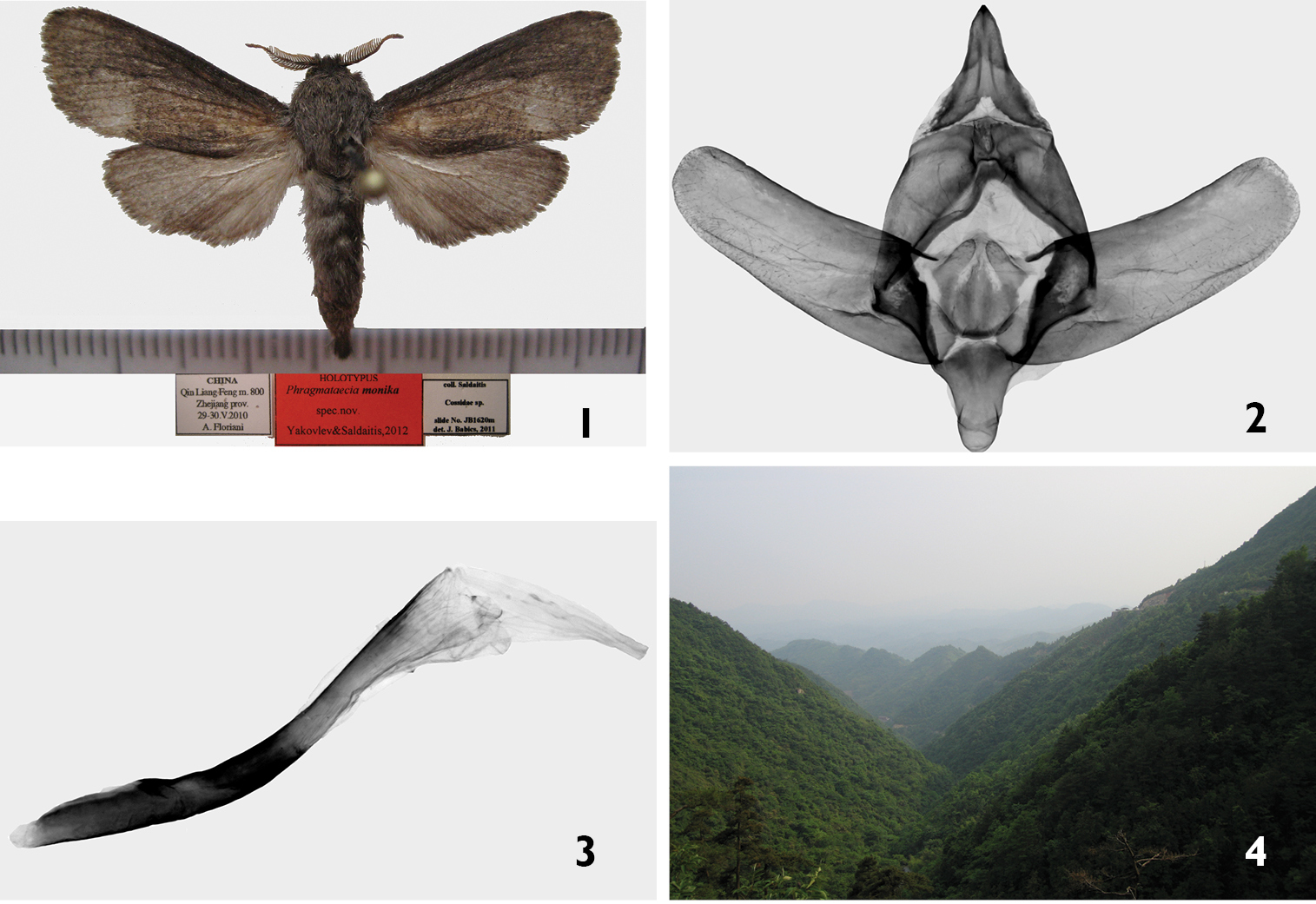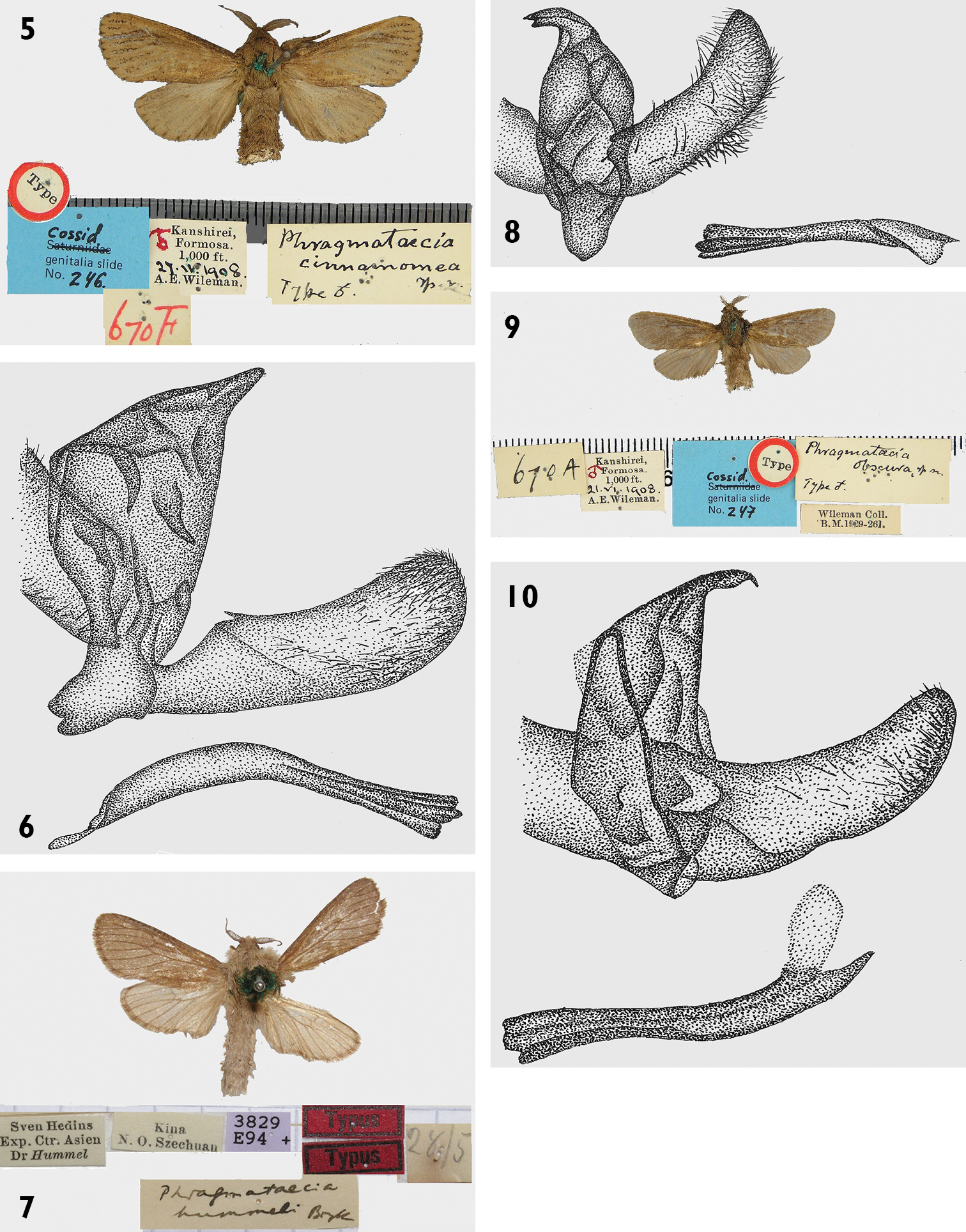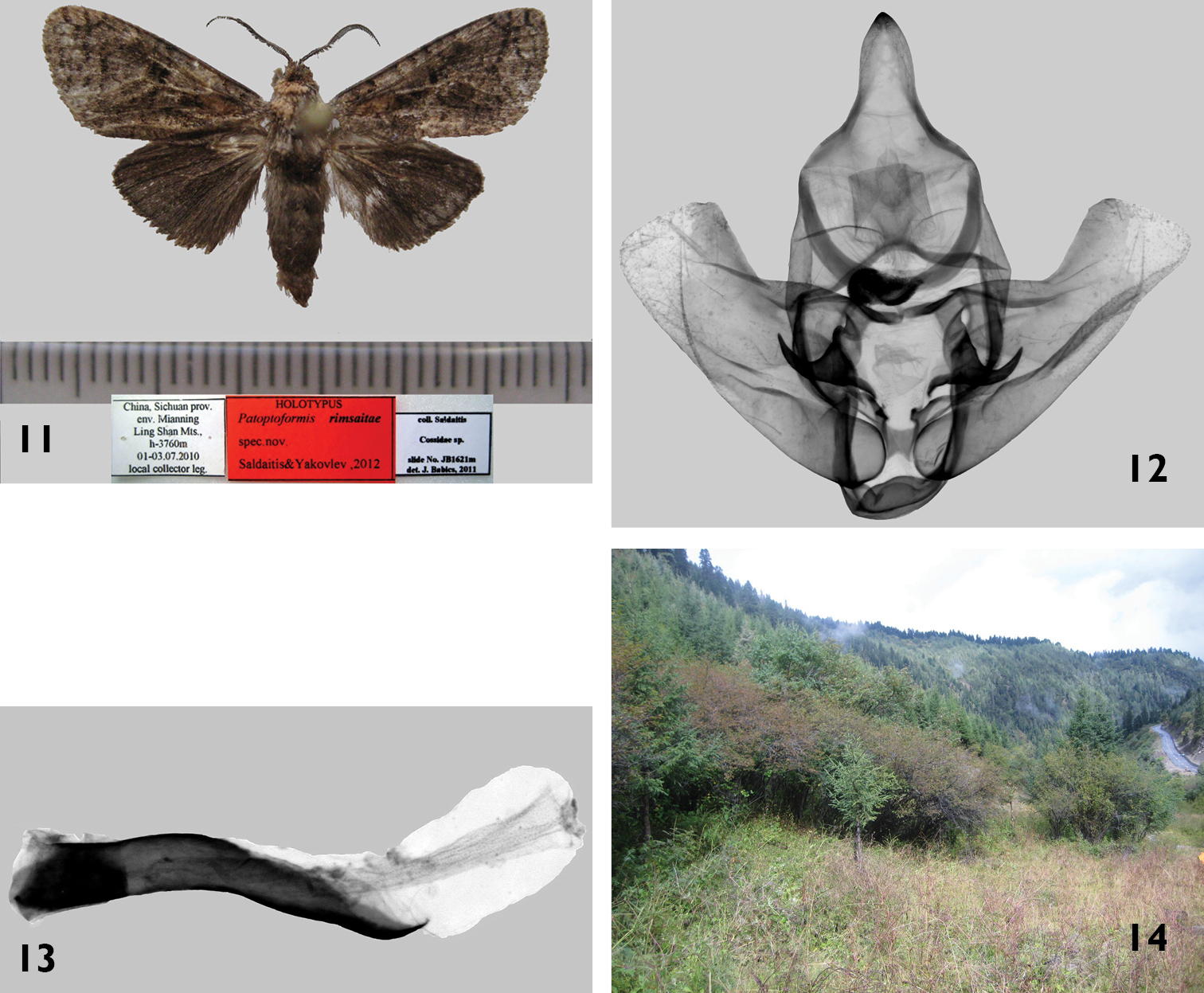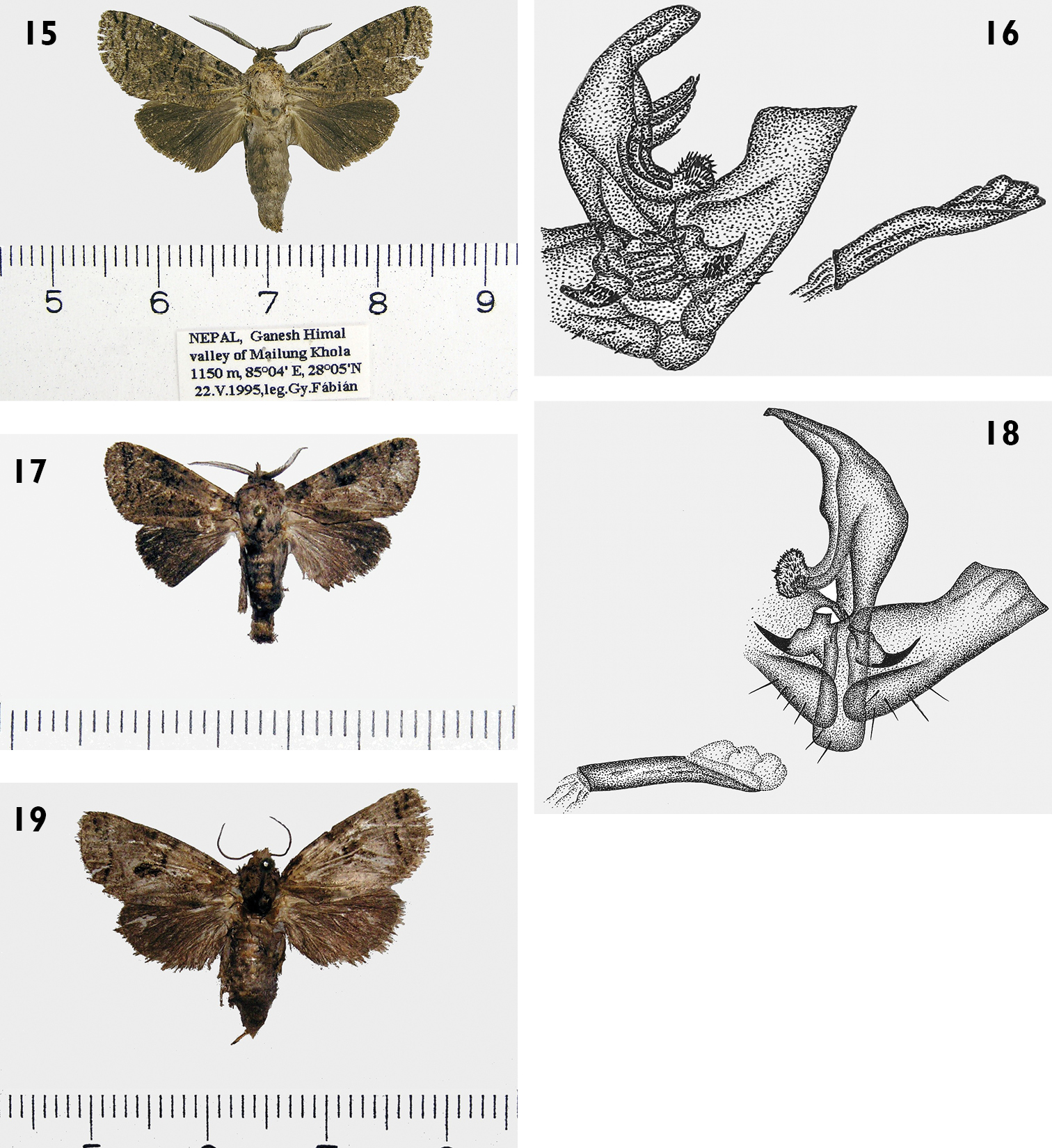






(C) 2012 Povilas Ivinskis. This is an open access article distributed under the terms of the Creative Commons Attribution License 3.0 (CC-BY), which permits unrestricted use, distribution, and reproduction in any medium, provided the original author and source are credited.
For reference, use of the paginated PDF or printed version of this article is recommended.
Two new Cossidaespecies from China‘s Zhejiang and Sichuan provinces are described. The new species Phragmataecia monika sp. n.and Patoptoformis rimsaite sp. n. superficially resemble related congeners but can be distinguished by differences in wing pattern, genitalia and distribution. Checklists of the genera Phragmataecia and Patoptoformis are presented.
Cossidae, Phragmataecia, Patoptoformis, new species, China
During a study of the Cossidae collection at the Zoologische Staatssammlung der Bayerischen Staaten (Munich, Germany)/Museum of Thomas Witt (Munich, Germany) the authors found two unknown specimens from China belonging to the genera Phragmataecia and Patoptoformis. After examining their morphology relative to related species the authors are describing the new species herein.
Materials and methodsThe material was collected in 2010, during May and July, using artificial light. Taxonomic nomenclature and checklists used in this study were compiled pursuant to consulting expert taxonomists and relevant literature (
Abbreviations of depositories:
ZSSM/MWM collection of Zoologische Staatssammlung der Bayerischen Staaten (Munich, Germany)/Museum of Thomas Witt (Munich, Germany).
Systematic accountshttp://species-id.net/wiki/Phragmataecia
Noctua arundinis Hübner, [1808]
Members of this genus are generally medium sized with very long abdomens, especially in females, and long bipectinate antennae. In males the length of pecten abruptly shortens to the distal part of tip, while in females pecten length is short to the tip of antenna as near invisible papilla. Coloration is white to black with unexpressed wing patterns except small black dots between the vein of the forewing in females.
Uncus base short and wide, tip acute; tegumen medium size; gnathos reduced; valvae lancete-shaped with even edges, gradually narrowing to rounded tip; juxta wide with two lateral outgrowth patches; saccus elongated, semioval form; aedeagus long, weakly hooked and slightly longer than valva; vesica without cornutus, with pale indistinct opening.
Long oviductus; papillae anales elongated, ellipse form; apophyses posteriores about 1.5 times longer than apophysis anterioris; ostium opening immersed, cup-like; postvaginal plate indistinct; ductus thin, long; bursa sack rounded, small without signum and with insignificant bulla on lateral side.
39 species distributed in Old world excluding Papuan and Australian ranges.
urn:lsid:zoobank.org:act:A8A6C34C-3A71-43D5-8F96-754BCA5B921A
http://species-id.net/wiki/Phragmataecia_monika
Figs 1–4male (Fig. 1), China, Qin Liang Feng m.800 Zhejiang prov. [province] 29-30.V.2010 A. Floriani (slide No.JB1620), (deposited in ZSSM/MWM).
Externallythe new speciesis most similar to sibling species Phragmataecia cinnamomea Wileman, 1911, Phragmataecia hummeli Bryk, 1942and to Phragmataecia fusca Wileman, 1911. Phragmataecia cinnamomea differs by having a yellow-brown body and wings, veins covered with dark brown scales in the postmedian forewing and dark brown dots in the terminal area (Fig. 5) and male genitalia valvae which widen to the apical part (Fig. 6). Phragmataecia hummeli has a grey-brownbody and unicolor wing pattern with forewings lighter brown and hindwings grey brown (Fig. 7). Its male genitalia differ by the pointed shape of the valvae, the rounded and very wide saccus and straight aedeagus (Fig. 8). Phragmataecia fusca has a dark yellow-brown body (Fig. 9), forewings dark brown in postmedian part, and reddish-brown hindwings. Its male genitalia valvae are rounded at the apical part (Fig. 10).
Phragmataecia monika Saldaitis & Yakovlev sp. n. 1 Phragmataecia monika, male, holotype, China, Zhejiang prov. 2 Phragmataecia monika, holotype, male genitalia capsule prep. Nr. UFO1 3 Phragmataecia monika, holotype, male genitalia aedeagus prep. Nr. UFO1 4 Type locality of Phragmataecia monika, China, Zhejiang prov.
Phragmataecia spp., adults and genitalia. 5 Phragmataecia cinnamomea Wileman, adult, holotypus. 6 Phragmataecia cinnamomea Wileman, holotypus, male genitalia 7 Phragmataecia hummeli Bryk, adult, holotypus8 Phragmataecia hummeli Bryk, holotypus, male genitalia 9 Phragmataecia fusca Wileman(= Phragmataecia obscura Wileman, 1911 adult 10 Phragmataecia fusca male genitalia.
Male (Fig. 1): Forewing length of holotype 14 mm, wingspan 31 mm. Antennae one-third the length of forewing; last third strongly bipectinate with very short triangular pecten. Ground color of forewings blackish brown; median part of wing from base to inner edge yellow brown extending to j-shaped wing edge; cilia yellow mixed with brown scales; hindwing unicolor yellow, cilia greyish brown; dorsal forewing dark brown, anal edge grey; dorsal hindwing dark brown, costal area black brown. Head, thorax blackish brown.
(Figs 2, 3): Uncus wide, strong narrowing to acute tip; valvae almost the same width as length, flat tips with long blunt outgrowths at base; tegumen wide in medial part with plunging wide neckline; saccus long, narrow, rounded; juxta wide with a pair of lateral processes; aedeagus longer than valva, thin, curved and at the tip twice wider than base.
Unknown.
Known only from the Qin Liang Feng Shan mountains in Zhejiang province of eastern China (Fig. 4), Phragmataecia monika is likely endemic to East China. The single male specimen was attracted to light in late May at an altitude of 800m in mountainous virgin mixed forest habitat dominated by various broad-leaved trees such as oak Quercus dentata, Quercus glauca, poplar Populus cathayana, Populus simonii, elm Ulmus parvifolia, rhododendron Rhododendron brachycarpum, Rhododendron dauricum, and bamboo Phyllostachys spp., Borinda spp., Fargesia spp. Suspected host plantsare Phragmites spp.
The new species is named after Monika Rimsaite, daughter of the second author.
Key to species Phragmataecia related to Phragmataecia monika based on external characters
| 1 | Forewings dark colored | 2 |
| – | Forewings light colored | 3 |
| 2 | Forewings blackish brown | Phragmataecia monika sp. n., China: Zhejiang |
| – | Forewings dark brown | Phragmataecia fusca Wileman, Taiwan |
| 3 | Forewings light brown | Phragmataecia hummeli Bryk, China |
| – | Forewings yellow brown with dark brown scales group and dots in terminal part | Phragmataecia cinnamomea Wileman, China, Taiwan |
Key to species Phragmataecia related to Phragmataecia monika based on male genitalia
| 1 | Saccus long rounded | 2 |
| – | Saccus short or slightly bilobed | 3 |
| 2 | Valva almost the same width as length | Phragmataecia monika sp. n., China: Zhejiang |
| – | Valva in the apical part pointed | Phragmataecia hummeli Bryk, China |
| 3 | Valva rounded, wider in the apical part | Phragmataecia cinnamomea Wileman, China, Taiwan |
| – | Valva in the apical part slightly narrowed, rounded | Phragmataecia fusca Wileman, Taiwan |
http://species-id.net/wiki/Patoptoformis
Patoptoformis hanuman Yakovlev, 2006.
Small dark colored moths with dark hair densely covering the body. Antennae bipectinate. Forewing with a scarcely seen streaky pattern; hindwing dark without pattern; fringe evenly dark on both wings. Sexual dimorphism weakly expressed but female somewhat larger than male with wider wings and non-pectinate antennae.
Uncus long, narrowly triangular with pointed apex; gnathos arms long and densely covered with spinules; valva with costal crest, blunt apex and scarcely noticeable transition between sclerotized and membranous parts, sclerotization gradually weakening towards apex; arms of transtilla small, pointed; juxta small; saccus very poorly expressed; aedeagus short, vesica opening occupies a dorso-apical position and comprises half of aedeagus length; vesica without cornuti.
Papillae anales elongated with rounded apices; apophyses posteriores thin, twice as long as anteriores; ostium opening immersed, fissure-like, surrounded by cordate rim; ductus bursae membranous, long and narrow; bursa elongate, gradually inflating to apex; ductus seminalis thin, enters bursa near its junction with ductus bursae.
Three species distributed in NE India (Assam), Nepal, SE China (Sichuan).
urn:lsid:zoobank.org:act:2F9D4618-3ED3-454E-A454-65B85A0D89EB
http://species-id.net/wiki/Patoptoformis_rimsaitae
Figs 11–14Holotype: male China, Sichuan prov. [province], Env. [environs] Mianning Ling Shan Mts. [mountains], h[high], -3760 m 01-03. 07. 2010, local collector leg. (slide No.JB1620), (deposited in ZSSM/MWM).
Externallythe new speciesis most similar to sibling species Patoptoformis ganesha (Yakovlev, 2004) and Patoptoformis hanuman Yakovlev, 2006. Unlike the new species, Patoptoformis ganesha has dark forewings generally with a row of narrow transversal bands in medial and submarginal zones and black hindwings with a black fringe (Fig. 15). Male genitalia in Patoptoformis ganesha differ as its uncus is triangular, broad gnathos is densely set with spinules, valvae are cut near apex, arms of transtilla are hook-like and saccus is rounded (Fig. 16). In Patoptoformis hanuman the forewings are brown with a faint black streaky pattern with a clear submarginal streak and spot in the distal area and hindwings are dark brown, almost black (Figs 17, 19). Male genitalia differ in shape of the valvae which are narrower, the gnathos arms which are thicker and aedeagus which is somewhat curved in the middle (Fig. 18).
Patoptoformis rimsaitae Saldaitis & Yakovlev sp. n. 11 Patoptoformis rimsaitae Saldaitis & Yakovlev, holotype, Sichuan province 12 Patoptoformis rimsaitae, holotype, male genitalia, capsule, prep. Nr. UFO2 13 Patoptoformis rimsaitae, holotype, male genitalia, aedeagus, prep. Nr. UFO2 14 Type locality Patoptoformis rimsaitae, China, Sichuan.
Patoptoformis spp. adults and genitalia. 15 Patoptoformis ganesha (Yakovlev, 2004, holotypus 16 Patoptoformis ganesha, holotypus male genitalia 17 Patoptoformis hanuman Yakovlev, 2006 holotypus, male 18 Patoptoformis hanuman, holotypus, male genitalia 19 Patoptoformis hanuman, paratypus, female.
Male (Fig. 11): Forewing length of holotype 11 mm; wingspan 24 mm. Antennae almost half as long as forewing, strongly bipectinate and last third with very short triangular pecten; ground color of forewings grey blackish with large yellow patch in middle of basal area, middle part of wing from base to inner edge yellow brown, cilia yellow mixed with brown scales; hindwing unicolor yellow, cilia greyish brown; upper side of forewing dark brown, anal edge grey; upper side of hindwing dark brown, costal area black brown; head, thorax blackish brown.
(Figs 12, 13): Uncus wide with blunt tip; gnathos wide but arms narrow; valvae short, very wide at base narrowing to middle then widening abruptly at tip; arms of transtilla hook-like, thin, acute in tip; saccus wide, rounded; aedeagus almost the same length as valva, weakly curved with sharp curved tip; vesica like equilateral sack with opening size more than half of aedeagus length.
Unknown.
Known only from the China’s Sichuan province on the eastern edge of the Tibetan plateau. Patoptoformis rimsaitaeis likely endemic to West Sichuan. A single male was attracted to light at an altitude of 3700 m. The new species was collected in the shrubby transition between the mountain primary mixed forest and the alpine grassland zones (Fig. 14). Nothing is known about the early stages.
The species is named in honor of Dr Jolanta Rimsaite, a prominent expert of general entomology.
Key to species Patoptoformis based on external characters
| 1 | Forewings dark brow with reticulated patterns formed by black lines | 2 |
| – | Forewings dark brown without reticulated patterns but with big black patch | Patoptoformis hanuman Yakovlev, India: Assam |
| 2 | Forewings grey black with yellow patch | Patoptoformis rimsaitae sp. n., China: Sichuan |
| – | Forewings with row of narrow transversal bands in medial and submarginal zones | Patoptoformis ganesha (Yakovlev), Nepal |
Key to species Patoptoformis based on male genitalia
| 1 | Arms of transtilla hook –like, thin | 2 |
| – | Arms of transtilla hook –like, massive | Patoptoformis hanuman Yakovlev, India: Assam |
| 2 | Tip of valva flat, edges rounded | Patoptoformis rimsaitae sp. n., China: Sichuan |
| – | Tip of valva with pointed edge | Patoptoformis ganesha (Yakovlev), Nepal |
Checklist of the genus Phragmataecia
Phragmataecia albida Erschoff, 1874
= Pragmataecia erschoffi Reisser, 1962
Distribution. Iran, Turkmenistan, Uzbekistan, Kazakhstan, NW China (Kuldja), Afghanistan, SW Russia (S. Volga reg.) (
Phragmataecia andarana Clench, 1959
Distribution: Namibia, South Africa (
Phragmataecia anikini Yakovlev, 2011
Distribution: SW Mongolia (Hovd aimak, Dzhungarian Gobi desert) (
Phragmataecia annapurna Yakovlev, 2009
Distribution: Nepal (Annapurna Himal) (
Phragmataecia brunni Pagenstecher, 1892
Distribution: E. Africa (Tanzania) (
Phragmataecia castaneae (Hübner, 1790)
= Phalena (Bombyx) arundinis Hübner [1802-1808]
= Phalena castanea, Esper (1807)
= Phragmatoecia castanea Teich, 1884
= Phragmataecia castanea sicca Dannehl, 1829
= Phragmataecia castaneae f. fusca Lempke, 1961
= Phragmataecia castaneae leonadae Gomez Bustillo, 1977
= Phragmataecia meloina Gomez Bustillo & Fernandes-Rubio, 1976
= Phragmataecia sica Gomez bustillo & Fernandes-Rubio, 1976
Distribution: Central and Southern Europe, S. England, M. East, Caucasus, Transcaucasia, Turkmenistan, Kazakhstan, NW Iran, Iraq, Syria, Lebanon, Turkey, W. China, SW Siberia, Egypt, Tunisia, Morocco (
Phragmataecia cinnamomea Wileman, 1911
= Xyleutes Hansi Strand, 1915.
Distribution: Taiwan, S. China (Jianxi-Fujian border) (
Phragmataecia dushman Yakovlev, 2009
Distribution: Afghanistan (
Phragmataecia furia Grum-Grshimailo, 1890
Distribution: Uzbekistan, Tadzhikistan ?, Afghanistan (
Phragmataecia geisha Yakovlev, 2011
Distribution: Japan (
Phragmataecia gummata Swinhoe, 1892
= Phragmatoecia (sic!) lata Snellen, 1895
= Phragmatoecia (sic!) sordida Snellen, 1901
Distribution: China (Fukien, Lingping), Vietnam, Thailand, Indonesia (Java, Sumatra) (
Phragmataecia gurkoi Yakovlev, 2007
Distribution: NW Pakistan (
Phragmataecia fusca Wileman, 1911
= Phragmataecia obscura Wileman, 1911
Distribution: Taiwan (
Phragmataecia fuscifusa Hampson, 1910
Distribution: Sierra Leone, Nigeria (
Phragmataecia hummeli Bryk, 1942
Distribution: China (NE Sichuan) (
Phragmataecia impura Hampson, 1891
Distribution: India, Nepal, S. China (Hainan Isl., Zhejiang and Guangxi prov.), Vietnam, Laos, Thailand, Java (
Phragmataecia innominata Dalla Torre, 1923
= Phragmatoecia reticulata Hampson, 1910
Distribution: South Africa, Mozambique, Malawi (
Phragmataecia innotata (Walker, 1865)
Distribution: China, Vietnam, Laos, Thailand (
Phragmataecia irrorata Hampson, 1910
Distribution: Zimbabwe, South Africa, Namibia, Bostwana, Mozambique, Zambia, Malawi (
Phragmataecia itremo Viette, 1974
Distribution: Madagascar (
Phragmataecia laszloi Yakovlev, 2009
Distribution: Nepal (Annapurna Himal) (
Phragmataecia longivitta Candeze, 1926
Distribution: Laos (
Phragmataecia minima Hampson, 1891
Distribution: S. India (
Phragmataecia minor Moore, 1879
Distribution: Bangladesh, Myanmar ?, China (Lingping) (Cotes, Swinhoe 1887,
Phragmataecia monika Saldaitis & Yakovlev, sp. n.
Distribution: China Zhejiang province.
Phragmataecia okovangae Clench, 1959
Distribution: Namibia, South Africa (
Phragmataecia pacifica Yakovlev, 2007
Distribution: Russia, Caucasus, Daghestan (
Phragmataecia parvipuncta (Hampson, 1892)
Distribution: India, Sri Lanka, Vietnam (
Phragmataecia pelostema (Hering, 1923)
Distribution: Togo, Cameroon, Nigeria (
Phragmataecia pectinicornis (Strand, 1914)
Distribution: Central Sudan (
Phragmataecia psyche (Le Cerf, 1919)
Distribution: Benin? and different parts of Western Africa (
Phragmataecia purpureus Fletcher, 1927
Distribution: India (Bihar) (
Phragmataecia pygmaea Graeser, 1888
Distribution: SE Russia, Korea, NE China (Charbin) (Staudinger 1892, Staudinger & Rebel 1901,
Phragmataecia roborowskii Alpheraky, 1897
= Phragmataecia longialatus Hua, Chou, Fang & Chen, 1990
Distribution: NW China, S. Mongolia (
Phragmataecia saccharum Moore, 1879 (Walker, 1865)
Distribution: India (
Phragmataecia sericeata Hampson, 1910
Distribution: Ghana, Nigeria (
Phragmataecia sumatrensis Snellen, 1892
Distribution: Indonesia (Sumatra) (Snellen 1892,
Phragmataecia terebrifer Fletcher, 1927
Distribution: India (
Phragmataecia turkmenbashi Yakovlev, 2008
Distribution: Turkmenistan (Kopetdagh Mts., Valley of Ipay-Kala ) (
Checklist of the genus Patoptoformis
Patoptoformis ganesha (Yakovlev, 2004)
Distribution: Nepal, Ganesh Himal.
Patoptoformis hanuman Yakovlev, 2006
Distribution: NE India, Assam.
Patoptoformis rimsaitae Saldaitis &Yakovlev, sp. n.
Distribution: province China, Sichuan.
The authors are especially grateful to Mr Robert Borth (Milwaukee, United States) for English grammar suggestions, Ms Lina Jasiukonyte for ink drawings, Mr Janos Babics (Budapest, Hungary) for genitalia preparations, pictures and very useful suggestions on genitalia comparisons, Mr Alessandro Floriani (Milan, Italy) for providing habitat information and photos of Qin Liang Feng Shan mountains and to anonymous reviewers.



